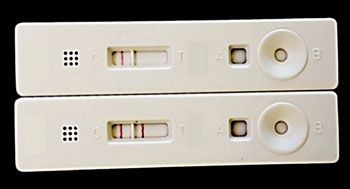Lateral Flow-Based Antibody Test Developed for Trachoma
By LabMedica International staff writers
Posted on 24 Aug 2016
Trachoma, resulting from repeated infection with the bacterium Chlamydia trachomatis, is the leading global infectious cause of blindness and blinding trachoma as a public health problem is targeted for elimination by 2020.Posted on 24 Aug 2016
A lateral flow-based assay (LFA) has been developed for the detection of antibodies against immunodominant antigen Pgp3 from Chlamydia trachomatis, the causative agent of urogenital chlamydia infection and ocular trachoma.

Image: The Lateral Flow Assay (LFA): results of the LFA run with positive (left) and negative (right) control sera (Photo courtesy of IHRC).
Scientists at the IHRC, Inc., (Centers for Disease Control and Prevention, Atlanta, GA, USA) and their colleagues collected serum samples from a community in Nepal in 2000, 2002, or 2014 as part of a study of trachoma post-mass drug administration sero-surveillance. There were 432 Nepalese whose ages ranged from 1to 90 years in the cohort. Additional samples from around the world were also collected including dried blood spots from 1 to 9 year olds in Tanzania, from which serum was eluted.
The lateral flow assay was prepared using conjugate reagents and capture reagents were prepared with optimal conditions. For the capture reagents, 1.5 mg/mL of Pgp3 protein and biotinylated bovine serum albumin were dispensed onto the test and control lines, respectively, of a nitrocellulose membrane at a rate of 0.1 μL/mm using an IsoFlow Dispenser (Imagene Technology, Hanover, NH, USA). The detection reagent or conjugate was prepared by conjugating Pgp3 to InnovaCoat Gold (Innova Biosciences, Cambridge, UK).
The investigators found that the optimization of Pgp3 concentration on the test line and capture reagents conjugated to colloidal gold using positive controls showed the strongest test line signal with the combination of Pgp3-colloidal gold and 1.5 mg/mL of Pgp3 as the capture reagent. The LFA yielded positive signals with serum and whole blood, but not with eluted dried blood spots. For serum, the agreement of the LFA with the non-reference multiplex assay was 96%, the specificity using non-endemic pediatric sera was 100%, and the inter-rater agreement was very high. For whole blood, the agreement of LFA with multiplex was 81.5%, the specificity was 100%, and the inter-rater agreement was also high. The LFA was tested in a field environment and yielded similar results to those from laboratory-based testing.
The authors concluded that their results show the successful development of a lateral flow assay for detection of antibodies against Pgp3 with reliable use in field settings, which would make antibody-based testing for trachoma surveillance highly practical, especially after cessation of trachoma elimination programs. The study was published in the August 2016 issue of the Journal of Immunological Methods.
Related Links:
IHRC
Imagene Technology
Innova Biosciences













